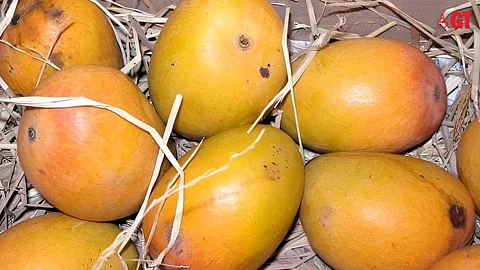

One of the things that visitors love about Goa is mangoes. The irresistible aroma of these juicy fruits fills the air in the summery months of April and May, making these months the best time to visit Goa if you want to enjoy the taste of the freshest mangoes.
But, a lot happens behind the scenes in the months before mangoes arrive in Goa’s markets.
Currently, it is mango flowering season. A mango tree often gives a bumper crop of fruit in one year, and a small or no crop the next year. Many factors can prevent flowering, fruit-set or even cause fruit drop.
The extended rainfall right up to November this year is a cause for concern – the mango crop may be very poor and the prices may go through the roof.
A mango tree often gives a bumper crop of fruit in one year, and a small or no crop the next year. Many factors can prevent flowering, fruit-set or even cause fruit drop.
Smudging or creating smoke under the tree canopy in the early morning or late in the misty evening in November-December, helps to induce flowering since smoke contains ethylene.
The contractors who lease the trees for the crop season simply spray the trees with ethylene generating chemicals.
Even before Goa received the ‘Geographical Indication’ or GI for the Mankurad variety of mangoes in 2023, the people’s refrain was, ‘Mango means Mankurad.’
It may have a GI for Goa, but the first fruits invariably come from across the border where mango growers have planted Mankurad mango grafts commercially.
We, in Goa, have to plant orchards and scientifically manage them to get a regular crop every year. Fortunately, this is happening now.
Last year, mangoes grown in Sattari were exported to the UK via Mopa airport in North Goa. There is a need to further boost Mankurad mango production.
Like the Devgad Alphonso or Hapoos, Goa’s favourite Mankurad mango is susceptible to spongy tissue, locally known as saka or lashem.
PROBLEMS & SOLUTIONS
Harvesting mangoes in the cool hours of the morning and removing ‘field heat’ in cool chambers is recommended. Application of lime powder to the soil helps to supply the much-needed calcium that is good for mangoes as it is good for our teeth and bones.
It helps to make the soil less acidic and reduces soil-borne fungi. Additionally, it acts as a repellent for termites during the dry season.
Whitewashing the bottom one metre of the mango tree trunk helps to prevent termites from climbing the trunk and makes detection of stem and bark borers, or rontto, easier.
In recent years, these beetles have been causing havoc across Goa and the rest of the Konkan region.
The Manga Hilario, or Mangilar, arrives in Goa’s markets almost a month after the Mankurad.
The Manga Hilario, or Mangilar, arrives in Goa’s markets almost a month after the Mankurad. Its fruits ripen during the monsoons and often have maggots of fruit flies. The Monserrate or Mussorad mango faces the same problem.
Pheromone-based fruit fly traps are now easily available and commonly used to overcome maggots. If you have not yet used one, visit your nearest Zonal Agriculture Office and learn all about it and buy one, too. In the fruiting season, it is difficult to find a pheromone trap when you need it the most.
Blackening and rotting of fruits as they ripen is another common problem. Spray the trees now with Pseudomonas fluorescens (Sparsh, Bio Cure B, etc) culture that will survive on the tree with the moisture from the mist.
The other option, ever since Millerdet was accidentally discovered it in 1885, is the Bordeaux mixture (Bordo) or the easier to use Copper oxy chloride (Copper blue, Fytolan, etc).
One can also spray Carbendazim (Bavistin, Fungy, etc). If the fungus is reduced now, the mangoes will be free from rotting later. It also prevents premature fruit drop due to fungus. So, spray now!
(The author is the former Chairman of the GCCI Agriculture Committee, CEO of Planter's Choice Pvt Ltd, Additional Director of OFAI and Garden Superintendent of Goa University, and has edited 18 books for Goa & Konkan)